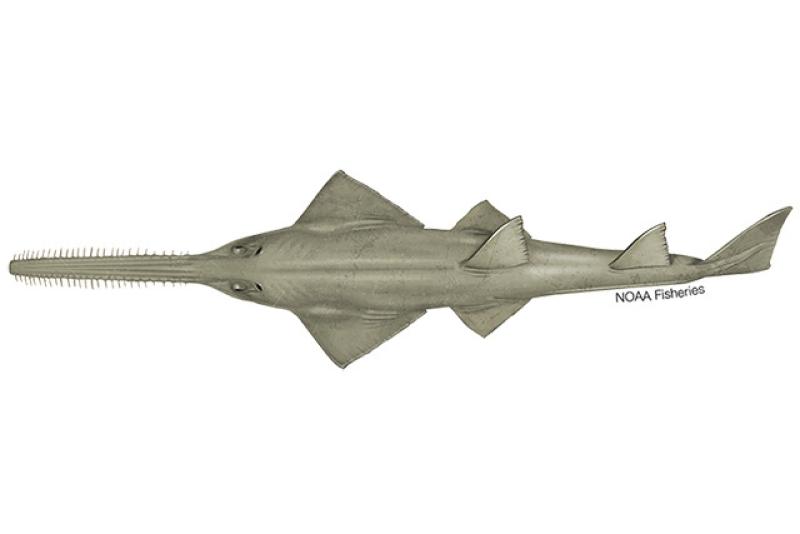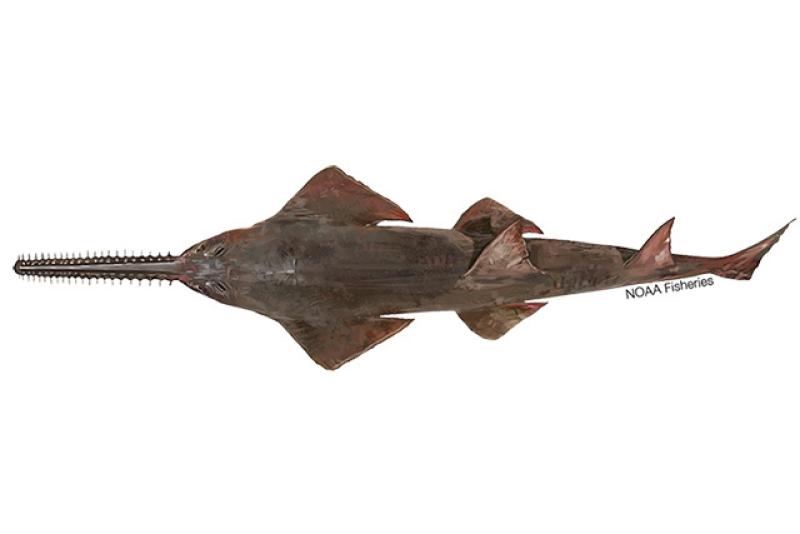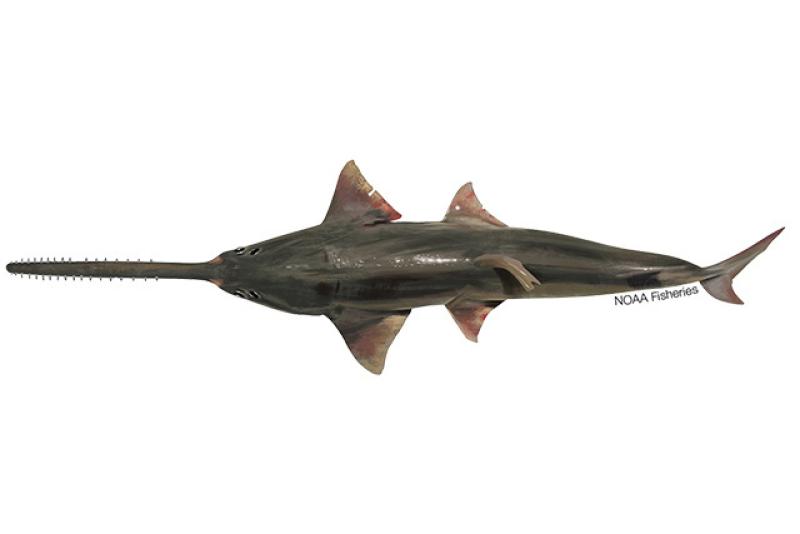Largetooth Sawfish
Pristis pristis
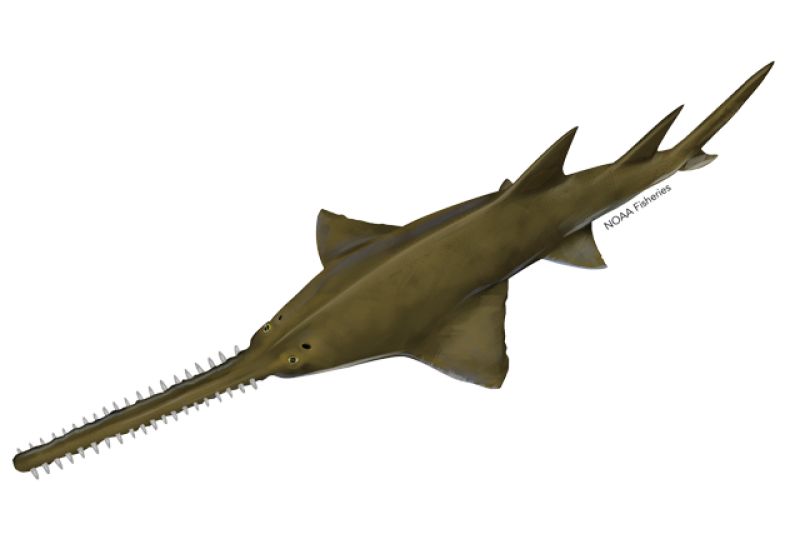
Protected Status
Quick Facts
 Largetooth sawfish - Photo: David Morgan, Murdoch University
Largetooth sawfish - Photo: David Morgan, Murdoch University
Largetooth sawfish - Photo: David Morgan, Murdoch University
About the Species
 Largetooth sawfish - Photo: David Morgan, Murdoch University
Largetooth sawfish - Photo: David Morgan, Murdoch University
Largetooth sawfish - Photo: David Morgan, Murdoch University
The largetooth sawfish is one of five species of sawfishes. Although sawfishes have shark-like bodies, they are actually a type of ray. They are named after their "saws" (rostra)—long, flat snouts edged with teeth. The largetooth sawfish has the largest historical range of all sawfish species, but its populations have dramatically declined worldwide. Largetooth sawfish and smalltooth sawfish are the two species of sawfish that have historically inhabited U.S. waters, though largetooth sawfish have not been found in the United States in more than 50 years. Both are listed as endangered under the Endangered Species Act.
Appearance
Largetooth sawfish are brown on top and have a white underside. Largetooth sawfish have 14 to 24 teeth that are uniformly spaced on each side of their snout. The rostrum is more robust than that of other sawfish species and tapers from the base of the head to the anterior tip. The first dorsal fin begins well forward of the pelvic fin origins and the caudal fin has a distinct lower lobe.
Behavior and Diet
Largetooth sawfish diet generally consists of a variety of fish, though molluscs and crustaceans (crabs and shrimp) may also be consumed. They use their rostra to slash through schools of fish, swinging it from side to side to impale and stun prey. Their rostra also contain electro-sensory organs, which can sense the weak amount of electricity produced by other animals. These organs help sawfish identify when prey is nearby.
Where They Live
Largetooth sawfish were historically found in tropical and subtropical waters around the globe including:
- Indo-Pacific region from Australia and southeast Asia to eastern Africa
- Eastern Pacific from Mexico to Peru
- Western Atlantic from the Gulf of America (formerly Gulf of c/m. Mexico) to Brazil
- Eastern Atlantic from Namibia to Mauritania
Largetooth sawfish are now considered extirpated or extremely rare in portions of their former range. The largest remaining populations are found in Australia, Amazonia, and the Indo-Pacific region.
They may be found ranging between saline coastal waters and freshwater lakes or billabongs far upriver. Neonates are generally found in very shallow freshwater environments where they can avoid predation. As largetooth sawfish grow, they expand their activity spaces and tend to use more marine coastal habitats.
 World map providing approximate representation of the largetooth sawfish's range.
World map providing approximate representation of the largetooth sawfish's range.
Lifespan & Reproduction
Largetooth sawfish participate in sexual reproduction and fertilization is internal. They are yolk-sac viviparous meaning their young are attached to yolk sacs that nourish the embryo inside the mother's body and emerge as fully developed pups. The length of the female gestation period, or pregnancy, is believed to be 5 months and females can give birth every other year. Pups are born with their rostrum and rostral teeth fully developed, but it is very flexible and sheathed in a thick gelatinous material to avoid injuring the mother at birth (the sheath dissolves quickly thereafter). A mother largetooth sawfish can have 1 to 13 pups per litter. Newborn sawfish are approximately 2.5 to 3 feet long (76-90 cm) at birth and grow 13 to 20 inches (33-52 cm) in the first year. Largetooth sawfish reach sexual maturity around 8 to 10 years when they’ve reached a size of about 10 feet. Maximum length of this species is recorded at just over 23 feet (705 cm).
Threats
Though affected by a variety of threats, habitat loss and bycatch mortality remain the largest threats to the existence of this species. Habitat alteration for mining, lumber, agriculture, and urbanization have reduced the quality and quantity of coastal and riverine habitat needed by largetooth sawfish. Given the largetooth sawfish’s dependence on freshwater areas as nursery habitat, changes to river flow and level have implications for juvenile survival. This potentially affects areas in which sawfish can give birth and juveniles can survive.
Sawfish are accidentally caught in a number of fishing gears, particularly gill nets, trawls, and hook and line tackle. Because sawfish have the potential to damage fishing gear and pose a threat to fishermen, they are often killed rather than being released unharmed. The high value of their fins in Asian markets and rostra for use in cultural ceremonies provides further incentive for retaining captured sawfish. Despite its endangered status, this species continues to be killed in both recreational and commercial fisheries throughout its range.
Scientific Classification
| Kingdom | Animalia | Phylum | Chordata | Class | Chondrichthyes | Order | Rhinopristiformes | Family | Pristidae | Genus | Pristis | Species | pristis |
|---|
Last updated by NOAA Fisheries on 08/21/2025
Featured News
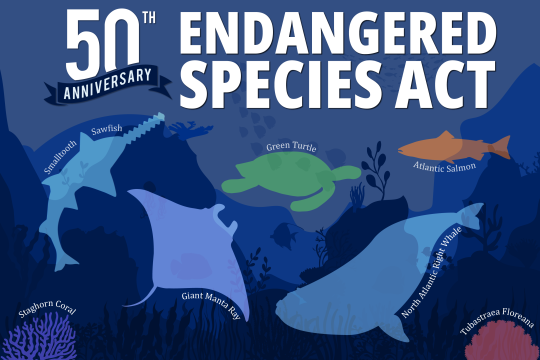
The Endangered Species Act: 50 Years of Conserving Species


 Tonya Wiley of Havenworth Coastal Conservation, Adam Brame of NOAA Fisheries, and Rachel Scharer of the Florida Wildlife Research Institute host the International Sawfish Day exhibit at the South Florida Museum in Bradenton, Florida.
Tonya Wiley of Havenworth Coastal Conservation, Adam Brame of NOAA Fisheries, and Rachel Scharer of the Florida Wildlife Research Institute host the International Sawfish Day exhibit at the South Florida Museum in Bradenton, Florida.
Management Overview
The largetooth sawfish is listed as endangered under the Endangered Species Act.
Additionally, the largetooth sawfish is listed under:
- Appendix I of the Convention on International Trade in Endangered Species of Wild Fauna and Flora (CITES)
- Annex II of the Protocol for Specially Protected Areas and Wildlife (SPAW).
Regulatory History
The largetooth sawfish was added to the candidate species list in 1988, removed in 1997, and placed back on the list again in 1999. In April 2009, NOAA Fisheries Service received a petition from WildEarth Guardians requesting that this species be listed under the Endangered Species Act.
We completed a status report in March 2010. On May 7, 2010, we published a proposed rule to list the species as endangered. On July 12, 2011, we published a final rule listing this species as endangered under the ESA.
In September 2010, we received a petition from WildEarth Guardians requesting that six species of sawfishes be listed under the ESA.
On June 4, 2013, we proposed to list the species as endangered. This proposed rule accepted a recently proposed taxonomic change to the sawfishes that resulted in the largetooth sawfish known as P. pristis being revised to include the species formerly known as P. microdon and P. perotetti. On December 12, 2014, we listed the largetooth sawfish under the ESA.
Key Actions and Documents
Last updated by NOAA Fisheries on 08/21/2025
Documents
Status Review of the Largetooth Sawfish (Pristis perotteti)
This status review summarizes the biological information gathered for an Endangered Species Act …
Last updated by NOAA Fisheries on 08/21/2025
